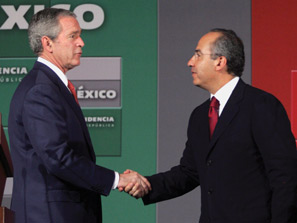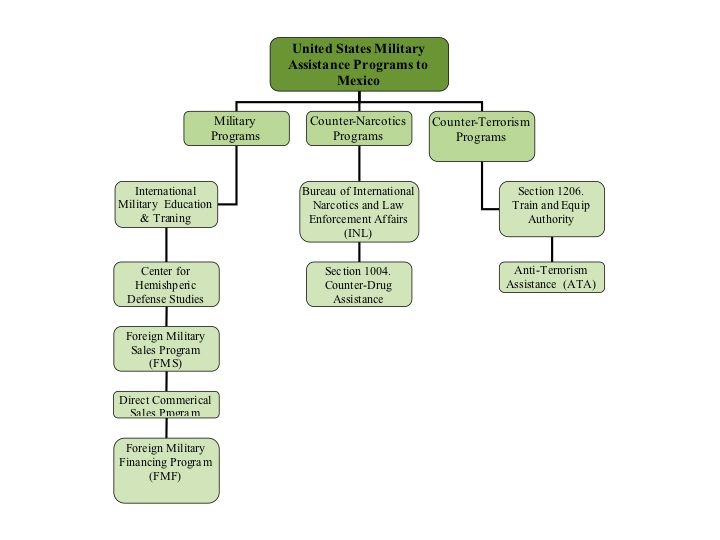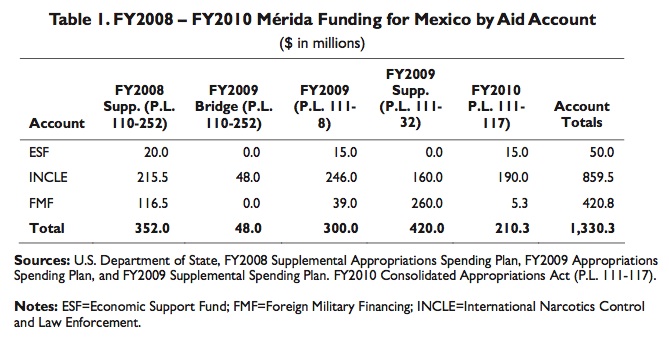 The beginning of U.S. military assistance to Mexico
The beginning of U.S. military assistance to Mexico
Despite a long history of military confrontation between Mexico and the United States throughout the 19th century and the first half of the 20th century, Mexico initiated a policy of military cooperation with the United States when World War II broke out that prevailed throughout the early 1940s.
World War II changed the correlation of forces globally, signifying the end of European hegemony and the rise of the United States as a world power. When the U.S. entered the war, it considered Mexico a key ally due to its strategic geographical position and its capacity to supply raw materials. At the time, the U.S. sought to coordinate the defense of the Pacific Coast in response to the Japanese attack on Pearl Harbor.
With this objective in mind, the Joint Mexican-United States Defense Commission was created in January 1942. In March of that year, the Lend-Lease Agreement was signed into law and became the first institutionalized plan for military assistance of the 20th century. Although Mexico received relatively little in terms of aid, the agreement represented the first stage of renewed military collaboration. However, the agreement was virtually dismantled when the war ended.
The Cold War and Military Contact
Once World War II ended, the Cold War began to germinate between the United States and the Soviet Union. Mexico was not oblivious to this conflict and decided to restrict military relations with the United States.
However, U.S. strategists insisted on negotiating a military agreement with Mexico. To that end, General Edward M. Jones arrived in Mexico in February of 1952 and began negotiations. The sticking point was the U.S. demand that Mexico sign a “Defense of Democracy” clause that required the Mexican government to commit to sending troops to fight on foreign soil under certain conditions. The Mexican government refused and rejected the military aid.
From then on until the 1990s, Mexico did not accept U.S. offers of military aid and did not participate in any joint military exercises or allow U.S. troops on Mexican soil. By 1967, all Latin American countries, with the exception of Cuba, Mexico and Haiti (whose military aid was suspended in 1963), hosted U.S. missions and received military assistance.[1]
That is not to say that all U.S.-Mexico military contact was suspended. In the same period, a rising number of Mexican soldiers and military officers received training in U.S. military institutions. For example, by 1964–fifteen years after the founding of the School of the Americas—the school had graduated 16,343 Latin Americans, of which 178 were Mexican. By 1963, a training center for officers in Fort Bragg, in North Carolina had graduated 112 officers, three of them from Mexico.[2]
This structure of minimal military relations remained stable until the 1990s, when joint aerial and naval exercises began in 1992 and 1993 respectively. By mid-decade, the U.S. State Department claimed it had more than forty-five Mexico programs involving the armed forces of both countries.[3]
In summary, Mexico went from a close military relationship with the United States during WWII, to a more moderate position during the Cold War, only to return to an intensification of military contact by the end of the 1990s.
Convergence of neoliberal economic policies and increased military ties
The 1990s once again brought about a new world order. The United States achieved military superiority based in large part on its economic power. New enemies took the place of the “communist threat,” including the war on drugs.
The North American Free Trade Agreement (NAFTA) was signed and went into effect during this period. In a memo written during negotiations and dated April 1991,[4] then-U.S. ambassador to Mexico John Negroponte summed up U.S. objectives. An FTA, he said, would modify Mexico’s traditionally neutral stance toward conflicts between other countries, “From a foreign policy perspective, an FTA would institutionalize acceptance of a North American orientation to Mexico’s foreign relations.”[5] In economic terms, NAFTA was to be “an instrument to promote, consolidate, and guarantee continued policies of economic reform in Mexico beyond the Salinas administration.”[6] In summary, the U.S. government saw NAFTA as a way to extend its political and economic hegemony over Mexico. Following an unprecedented lobbying campaign by the Salinas government, the U.S Congress approved the agreement, initiating the most important trade agreement between Mexico and the United States since World War II and profoundly changing the terms of engagement between the two nations.
On Jan. 1, 1994–the date the agreement went into effect–an indigenous army known as the Zapatista Army of National Liberation (EZLN, by its Spanish acronym) declared war on the Mexican government. The government responded by deploying special infantry and air force units to regain control of territories where the Zapatistas had influence. In the context of counter-insurgency efforts, U.S.-Mexico military ties increased substantially.
The change in the administration, the collapse of the Mexican economy in 1995, and the previously mentioned armed Zapatista uprising were elements that consolidated neoliberal economic policies and created an environment conducive to increased military ties with the Pentagon. It was no surprise that on Oct. 23, 1995, U.S. Secretary of Defense William Perry visited Mexico and proposed to the commanders of the Mexican Armed Forces the so-called “third link,”–increased military ties to complement tighter economic and political relations between the two countries.
The question is: Why was it so imperative to integrate the Mexican Armed Forces into military assistance schemes led by Washington? Mexican researcher Carlos Fazio notes that, “at this time (1995), the United States did not have access to the Mexican Armed Forces’ tactical and operational decision-making structures–the only Latin American institution, along with Cuba, that had not been directly penetrated by the Pentagon.”[7]
At this point, no fewer than eight different U.S. security and military mechanisms between the U.S. and Mexico were revitalized and modernized. The following diagram presents the most important of these programs, which have been divided into three different categories: military assistance, the war on drugs, and counter-terrorism measures:
As can be seen in the diagram, there are three clearly differentiated headings of assistance. There are two main types of programs under the heading of military mechanisms. The first is military training. In this area, Mexico has accepted the program of International Military Education and Training (IMET) and assistance from the Center for Hemispheric Defense Studies (CHDS). The second encompasses arms and equipment sales. This depends on Mexico deciding to make a purchase and the U.S. being willing to sell. Examples of this mechanism are the Foreign Military Sales program (FMS), the Foreign Military Financing program, (FMF) and Direct Commercial Sales (DCS) program. Up to this point, Mexico had been reluctant to accept this form of military assistance, because the United States has regularly used such assistance to exert influence and pressure on the defense and security policies of recipient counties.
The “war on drugs” seeks to establish a framework of assistance for combating narcotrafficking and organized crime, and is responsible for developing policies in line with this goal. Here the State Department has two strategic objectives: (1) to reduce the quantity of illegal drugs entering the United States and (2) to reduce the impact of international organized crime in the U.S. Furthermore, the drug war complements the U.S. anti-terrorist strategy, both directly and indirectly, by promoting the modernization of equipment and secondary operations in the penal system and law enforcement agencies by foreign governments. To this end, the United States created the Bureau of International Narcotics and Law Enforcement and Section 1004, from which Mexico receives resources.
Finally, the antiterrorism program aims are to create, build, and maintain foreign military contacts to strengthen their antiterrorist capabilities to deter, disrupt, and defeat extremist organizations by building infrastructure. The U.S. State Department provides arms, equipment training and services to aid the governments of other countries to prevent and decrease acts of terrorism such as bombings, kidnappings, assassinations, etc. Mexico also receives aid under this umbrella of assistance.
Other military dynamics
In addition to the mechanisms mentioned above, in December 1995 the two countries agreed on the transfer of military equipment for counternarcotics activities to Mexico and the training of Mexican military personnel in the United States. During the negotiations, they agreed that the U.S. would send 73 UH-1H helicopters and four C-26 fighter planes to Mexico. However, many years later it became known to the Mexican government and public that these planes had last been used in the Vietnam War, a scenario that prompted the Mexican government to return the delivered goods.
In April of 1996, the Clinton administration ordered the U.S. armed forces to carry out the Mexico Training Initiative designed to enhance the capabilities of Mexico’s armed forces. The MTI began work in April of 1996 in Fort Bragg, North Carolina. Here Mexican officers were trained in counternarcotics tactics, marksmanship, reconnaissance, hand-to-hand combat and human rights. This training program continued until September 1998, when it was suspended.
The events of Sept. 11, 2001 fundamentally altered the military relationship between the Mexico and the United States. From this moment on, the security agenda became paramount–a state of affairs not seen at least since WWII. A major defense and security initiative to emerge from these events was the formation of the Northern Command, or U.S. NorthCom.
U.S. NorthCom coordinates strategy and operations in the Northern Hemisphere. NorthCom was founded as a response to the events of 9/11 and was inaugurated on Oct. 1, 2002. On Sept. 11, 2003, it was granted total response capacity. The formation of the Command grew out of the 2002 National Security Strategy of then-President of George W. Bush. U.S. NorthCom is significant, in that it has become one of the most important partnerships among the armed forces of the three North American countries.
Years later, the three North American presidents established the Security and Prosperity Partnership of North America (SPP). The SPP is a framework for implementing trilateral measures and figures as one of the precursors of the Merida Initiative.
The military vortex of the Merida Initiative
The official version is that the Merida Initiative emerged from a proposal by the Mexican president Felipe Calderon to then-President George Bush regarding the need to coordinate efforts to strengthen the fight against organized crime. The meeting between the two presidents took place in Merida, Yucatan, on March 12-13, 2007.
However, doubts have arisen regarding the veracity of this claim. It is known that on Jan. 17, 2007, the Democratic Representative of Texas Henry Cuellar and Silvestre Reyes, president of the House Intelligence Committee presented the Prosperous and Secure Neighbor Alliance Act of 2007, a document that provided the basis for negotiation of what would later be called Plan Mexico or the Merida Initiative.[8] This casts doubt on the official statements and strongly indicates that the proposal originated with the U.S. government.
The new framework for U.S.–Mexico security relations was officially announced on Oct. 22, 2007. Entitled The Merida Initiative: A New Paradigm for Security Cooperation, the pact focused on combating illegal drug-trafficking, coordinating law enforcement efforts and fighting transnational organized crime.[9] After many months of negotiations, on June 30, 2008, President George W. Bush signed into law HR 2642, a supplemental appropriations bill containing resources for the Merida Initiative, which included a budget of $352 million dollars.
For 2010, according to the latest United States Congressional report, the budget for the Merida Initiative for Mexico is $210.3 million dollars. The report summarizes the funds:[10]
The majority of the aid to Mexico has been channeled to Mexican police forces and the military. Within that, the International Narcotics Control and Law Enforcement (INCLE) mechanism has been allocated a total of $859.5 million dollars. These funds are primarily to be distributed to the Ministry of Public Security and police forces and federal law enforcement agency, the Attorney General’s Office (SSP and PGR, by their Spanish acronyms).
Funds allocated to the armed forces through the “Foreign Military Financing” (FMF) program have been assigned a budget of $420.8 million dollars to the Departments of National Defense and the Navy. Only $50 million dollars are designated for the “Economic Support Fund.”
The Merida Initiative debate
For the Mexican armed forces, the Merida Initiative represents a level of collaboration not seen since at least 1942, when the Joint Mexican-United States Defense Commission was initiated. This change has tremendous importance because it roots Mexico’s war on drugs within the military-policing scheme promoted by Washington, as seen in an analysis of the resources allocated to the armed forces and police.
The Merida Initiative has serious strategic weaknesses. First, the initiative does not seek to resolve the problem in an integral manner. Its punitive and military-policing focus designed by the United States to fight the war on drugs has been proven to be inefficient in eliminating illegal drug trafficking and organized crime.
Second, it allows almost unprecedented involvement of the United States in Mexican security programs and operations. The problem of drug trafficking and organized crime is real. However, it is unacceptable that the U.S. government dominate the orientation of Mexican security policies. It is equally unacceptable that the Mexican government has still not formulated a real State strategy and policy on security.
The results of these failings has been an increase in violence, human rights violations, arms trafficking, huge profits for traffickers, and the bloody consequences of a government that attacks society.
It’s insulting that the Mexican armed forces that should serve as the custodians of liberty, are depriving innocent and defenseless citizens of their civil liberties in the context of the Merida-supported war on drugs. As the late Mexican writer Carlos Montemayor said, “There is no justification nor dignity in any authority when state violence turns against society itself.”[11]
The solution to the drug trafficking problem is not exclusively found in the police and military approach, but in viewing this situation from a integral perspective. With half of the population living in poverty, without a system to provide prompt and expeditious justice, without respect for the rights enshrined in the Mexican Constitution, and without acknowledging drug use and abuse as a public health issue, the situation will continue to spiral out of control.
It is necessary to strengthen police forces and build up a civil justice system that respects and upholds the rule of law, and to root out corruption. Internationally, there should be more effective coordination with the United States, without allowing the U.S. government and Armed Forces to define and dominate the Mexican security agenda. Furthermore, it is important to reach out and establish agreements with Central and South American countries that are also facing the problem of drug trafficking.
Finally, it is worthwhile to recall the exploits of Sinon in the Trojan War. As in the Greek epic, the United States—historically prevented from penetrating Mexican military structures–resorted to a ploy and built the Merida Initiative (the Trojan Horse). Like Sinon the Greek spy, members of the U.S. government convinced the Mexicans that this was a gift. The Greek myth relates that when the horse entered the city of Troy, Sinon released the armed Greek soldiers hiding within it. They killed the guards and opened the door to his army, which rushed in to capture and burn the city.
Let us hope the Merida Initiative is not a Trojan horse sent to Mexico, and that Washington’s military/police assistance ceases to contribute to the chaos and disorder that has only deepened since it began.
Jonathan Agustín González Torres has a Bachelor’s in International Relations from the National Autonomous University of Mexico, and he is currently working on his Master’s degree in Mexico-U.S. Studies at the School of Advanced Studies Acatlán. His areas of research include Mexico-U.S. relations, National Security, Armed Forces, and drug trafficking. He is a contributor to the Americas Program.
Translators: Isabella Weibrecht, Lindsay Hooper, and Laura Carlsen.
Editor: Laura Carlsen
Works Cited:
[1] Mario Ojeda. Alances y límites de la política exterior de México, México, El Colegio de México, 2001, p. 76.
[2] Ibid., pp. 179-80.
[3] Howard Wiarda, “Beyond the Pale: The Bureaucratic Politics of United States Policy in Mexico”, World Affairs, Vol.162, Issue 4, primavera de 2000, p. 185.
[4] A Latin word that means “something to remember.”
[5] Sergio Aguayo, El panteón de los mitos: Estados Unidos y el Nacionalismo mexicano, México, Ed. Grijalbo, 1998, p. 284.
[6] Ibid., p. 284
[7] Carlos Fazio, El tercer vínculo, México, Ed. Joaquín Mortiz, 1996, p. 179.
[8] Mario Cruz, “Plan Colombia e Iniciativa Mérida: piezas estratégicas de la hegemonía continental”, Op. Cit., p. 352.
[9] Vid., Iniciativa Mérida, “La Iniciativa Mérida: nuevo paradigma de cooperación en materia de seguridad”, [online], México, October 22, 2007, URL address: http://www.iniciativamerida.gob.mx/pdf/declaracion_conjunta_Iniciativa_Merida_esp.pdf, [viewed: January 10, 2010].
[10] Vid., Clare Ribando, “Merida Initiative for Mexico and Central America: Funding and policy issues”, [online], Estados Unidos de América, enero de 2010, URL address: http://www.wilsoncenter.org/topics/pubs/M%C3%A9rida%20Initiative%20for%20Mexico%20and%20Central%20America%20Funding%20and%20Policy%20Issues.pdf, [viewed: April 3, 2010].
[11] Carlos Montemayor, “Agravio a la sociedad”, [online], México, 2 de marzo de 2010, la jornada.unam.mx Dirección URL: http: //www.jornada.unam.mx/2010/03/02/index.php?section=opinion&article=a08a1cul, [viewed: March 2, 2010].





